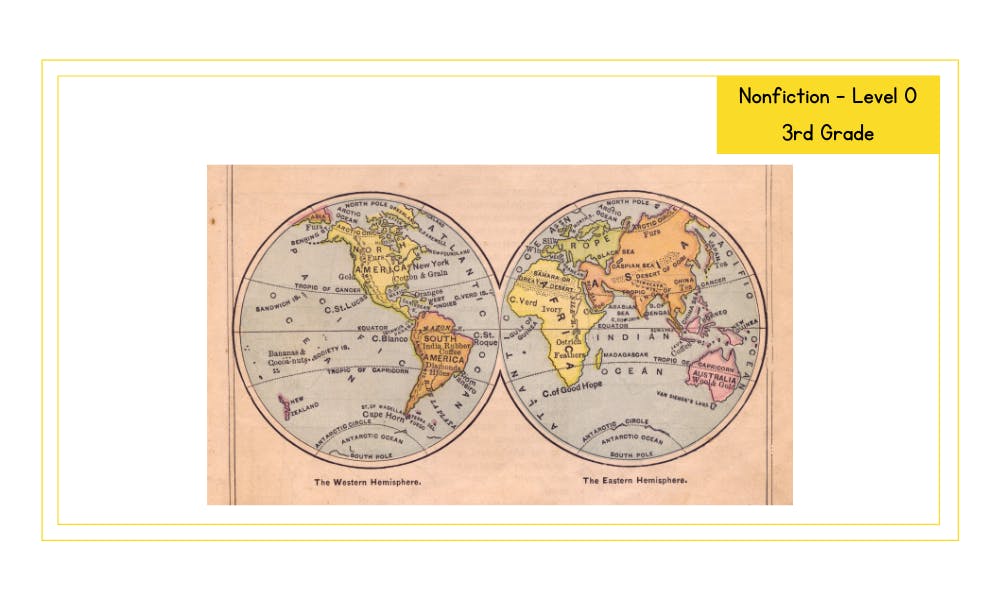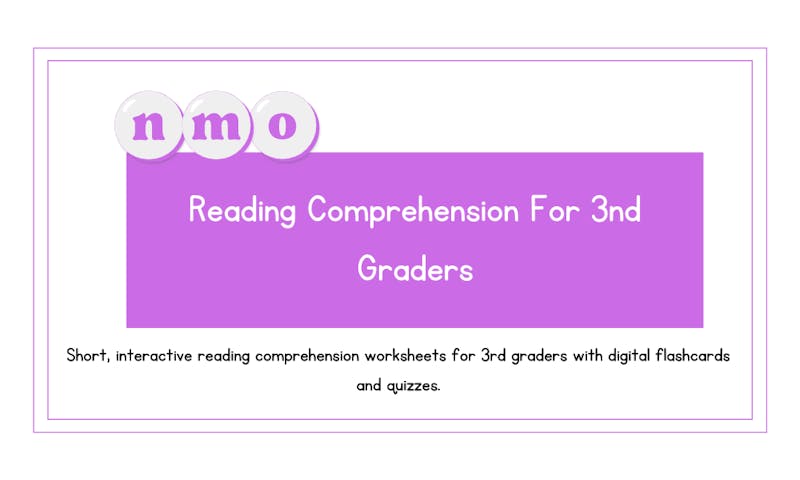Reading comprehension for 3rd graders is the stepping stone to creating curious and knowledgeable students in reading. In the following 3rd-grade reading comprehension worksheets, students will work on fact vs. opinion to identify whether statements made represent facts or opinion; with a short quiz at the end, they will also work on comparing and contrasting an account of a short nonfiction story about two African animals to identify how the animals are alike and how they differ. Scroll down for reader-level stories N-P suitable for 3rd graders at home or school.
Common Core Standards for Literacy and Informational Texts
Our fact vs. opinion and comparing and contrasting 3rd-grade reading comprehension worksheets work on the following Common Core Standards.
- CCSS.RL.3.4, CCSS.RL.3.6, and CCSS.RL.3.9.
- CCSS.RI.3.2, CCSS.RI.3.6, and CCSS.RI.3.9.
Our reader-level N-P 2nd-grade reading comprehension worksheets work on the following Common Core Standards.
- CCSS.RL.3.1, CCSS.RL.3.3, CCSS.RL.3.4, CCSS.RL.3.5, CCSS.RL.3.6, and RL.3.7.
- CCSS.RI.3.1, CCSS.RI.3.2, CCSS.RI.3.3, CCSS.RI.3.4, CCSS.RI.3.6, CCSS.RI.3.7, RI.3.8.
Fact vs. Opinion
Students in the 3rd grade need to learn how to distinguish fact from opinion. In this 3rd-grade reading comprehension worksheet, students have to read the short text and answer some comprehension questions to identify whether statements in the text represent a fact or an opinion. Scroll down for a quick reading comprehension checkpoint quiz based on the text.
What is a fact?
What is an opinion?
The Perfect Gift
Read through the story and as you go, identify what might be a fact and what might be an opinion to answer some reading comprehension questions.
Note: a teacher or guardian should read along with the student and give help when needed.
Simply scroll down to read the story and click the right button to move on to the next page.

It was almost the winter holidays, and Louise still hadn't bought any gifts. Her brother, Fred, was visiting, and she needed to find the perfect gift for him. Last year Fred bought her a new watch, and she wore it every day. Mom always took Louise shopping to buy gifts, but she was too busy with work this year.

Louise was looking online for gift ideas when her dad asked her to go with him to the mall. Her dad showed her a sweater in the mall with a Star-Wars picture. Her dad thought Fred would love it, so Louise bought it.

She also saw a Star Wars backpack, and she thought it would be a great gift for Fred. When they got home, she showed her mom, and her mom said Fred would love them.
Reading Comprehension The Perfect Gift Question Quiz
Read through the story and try out our quiz. Got a question wrong? Don't worry. Just press reset, and the question will start over.
Are the following statements fact or opinion?
Louise’s mom thinks that Fred will love the gifts.
Choose the best answer from the choices below
Louise wears the watch Fred gave her every day.
Choose the best answer from the choices below
It was almost the winter holidays.
Choose the best answer from the choices below
Louise and her dad went to the mall.
Choose the best answer from the choices below
Louise's mom was too busy with work to take her shopping.
Choose the best answer from the choices below
Louise thinks the backpack would be a great gift for Fred.
Choose the best answer from the choices below
Comparing & Contrasting
Here is a short text followed by a reading comprehension quiz suitable for 3rd graders. Students must read the text and then, using contextual clues, answer questions to identify what the characters have in common and what makes them different.
Note: a teacher or guardian should read along with the student and give help when needed.
What is comparing?
What is contrasting?
African Animals
Simply scroll down to read the story and click the right button to move on to the next page.

Africa is home to many of the world's most famous animals, animals that you often see in zoos and on T.V. programs around the world.
Lions, tigers, giraffes, antelopes, zebras, and leopards are some of them, and they each have similarities and differences in how they live. As you are reading, think about how they are different and what makes them similar.

Lions are mammals, and they live in groups or packs. African lions mostly live in sub-Saharan Africa, in grasslands and savannas, where they find water and prey. To eat, they hunt for zebras, deer, and other animals every few days. Lions also sleep for about 16-20 hours a day. Lions used to live in other parts of Africa, but now they are at risk of extinction in North and West Africa.

Plains zebras live in grasslands and savannas in Africa's east and south sub-Saharan. Zebras are mammals, and they live in groups or herds. To eat, they find grass, leaves, and herbs; zebras are herbivores. They sleep for about 7 hours a day but are always alert, so they don't get attacked. There are 3 types: the plains zebra, Grevy's zebra, and mountain zebra, all native to Africa, but mountain zebras and Grevy's zebras are at risk of extinction in Kenya, Ethiopia, Namibia, and South Africa.
Reading Comprehension African Animals Question Quiz
Read through the story and try out our quiz. Got a question wrong? Don't worry. Just press reset, and the question will start over.
The animals are mammals.
Choose the best answer from the choices below
This animal eats grass, leaves, and herbs.
Choose the best answer from the choices below
This animal eats zebras, deer, and other animals.
Choose the best answer from the choices below
They live in the sub-Saharan grasslands and plains.
Choose the best answer from the choices below
They are at risk of extinction.
Choose the best answer from the choices below
3rd Grade Reading Comprehension Worksheets with Quiz & Flashcards
The following reading comprehension for 3rd-grader digital worksheets are designed to be used on an electronic device and include common high-frequency words and topics suitable for 3rd-grade students. We have a nonfiction reading comprehension worksheet for reading levels N-P with standard-based topic-specific flashcards and a quick quiz to check for understanding.
Seasons Around The World Short Reading Comprehension Story, Flashcards & Quiz - N-P
Simply scroll down to read the story and click the right button to move on to the next page. The first slideshow is for reader levels N, the second for O, and the last one is for P.

Level N
The four seasons, winter, summer, spring, and fall, have different types of weather. In winter, it is normally cold, and plants find it hard to grow. In spring, plants and flowers grow, and trees blossom. Summer is the hottest time, and there is the most daylight. It is cooler in fall, and leaves fall from the trees, ready for winter.
What is your favorite season?

Level O
There are four seasons, and the seasons change depending on where you live. The Equator divides the Earth into two halves, the Northern and Southern hemispheres. Seasons in the Northern hemisphere are opposite to those in the Southern hemisphere. So that means that in countries like Argentina and Australia, winter starts in June as they are in the Southern hemisphere. In countries like France, U.S., and England, winter starts in December as they are in the Northern hemisphere.
The four seasons, winter, summer, spring, and fall, have different types of weather. In winter, it is normally cold, and plants find it hard to grow. In spring, plants and flowers grow, and trees blossom. Summer is the hottest time, and there is the most daylight. It is cooler in fall, and leaves fall from the trees, ready for winter.
What is your favorite season?

Level P
There are four seasons, and the seasons change depending on where you live. The Equator divides the Earth into two hemispheres or halves. There are four hemispheres, Northern, Southern, Eastern, and Western, and seasons in the Northern hemisphere are opposite to those in the Southern hemisphere. So that means that in countries like Argentina and Australia, winter starts in June as they are in the Southern hemisphere. In countries like France, U.S., and England, winter starts in December as they are in the Northern hemisphere.
Dividing the world into Eastern and Western hemispheres has historically been based on what countries own or have, but now, it is used for geography and politics. The Eastern hemisphere was called the "Old World," and the West was called the "New World." However, these names aren't used now.
The four seasons, winter, summer, spring, and fall, have different types of weather. In winter, it is normally cold, and plants find it hard to grow. In spring, plants and flowers grow, and trees blossom. Summer is the hottest time, and there is the most daylight. It is cooler in fall, and leaves fall from the trees, ready for winter.
What is your favorite season?
Seasons Around The World Reading Comprehension Standard-Based Flashcards
These digital flashcards are designed to be used on an electronic device. They have story-specific keywords from each story and are grouped into reading levels N-P. You can use them to go over specific high-frequency words and vocabulary to complete the sentences. Simply flip the flashcard over, and get the answer.
Reading Comprehension Seasons Around The World Question Quiz
Read through the story and try out our quiz. Got a question wrong? Don't worry. Just press reset, and the question will start over.
Note: for reader levels N and O, answer questions 1-4. Reader level P can answer all of them after reading through the text.
1. From the text, what does it say happens to leaves in the fall?
Choose the best answer from the choices below
2. From the text, what does it say happens to the weather in winter?
Choose the best answer from the choices below
3. How many seasons are there?
Choose the best answer from the choices below
4. In spring, _________, and flowers _______.
Choose the best answer from the choices below
5. Seasons change depending on where you _________.
Choose the best answer from the choices below
6. The Eastern hemisphere was once called the ____________?
Choose the best answer from the choices below
7. The Western hemisphere was once called the ____________?
Choose the best answer from the choices below
8. Seasons in the Northern hemisphere are ____________ to those in the Southern hemisphere.
Choose the best answer from the choices below
